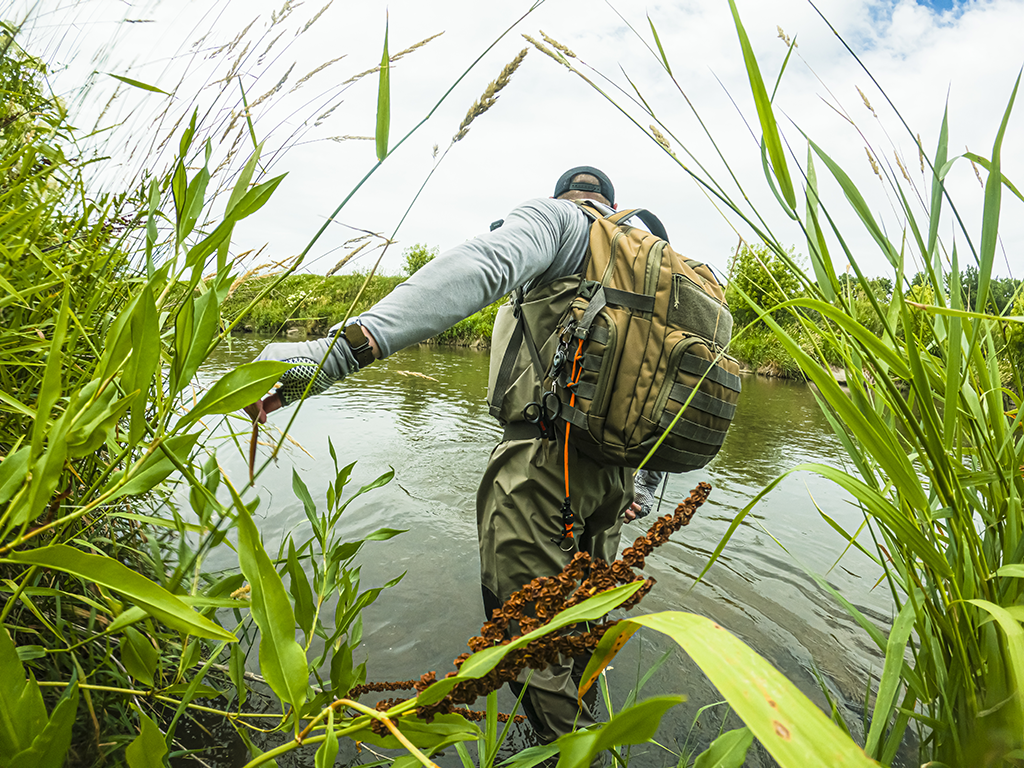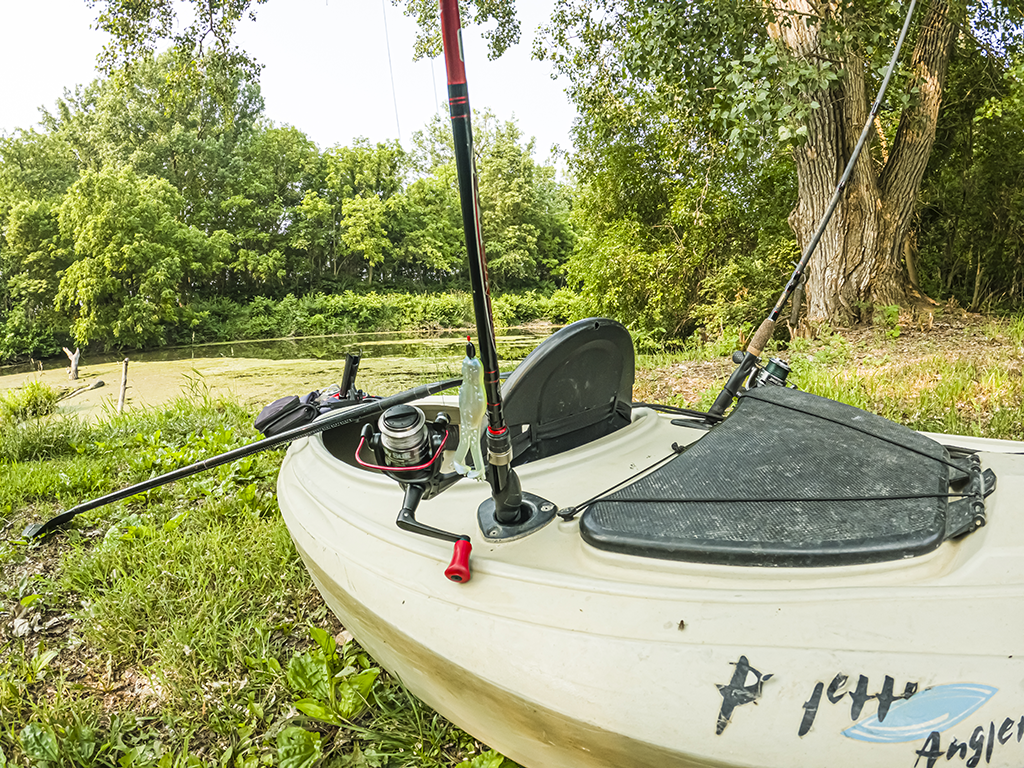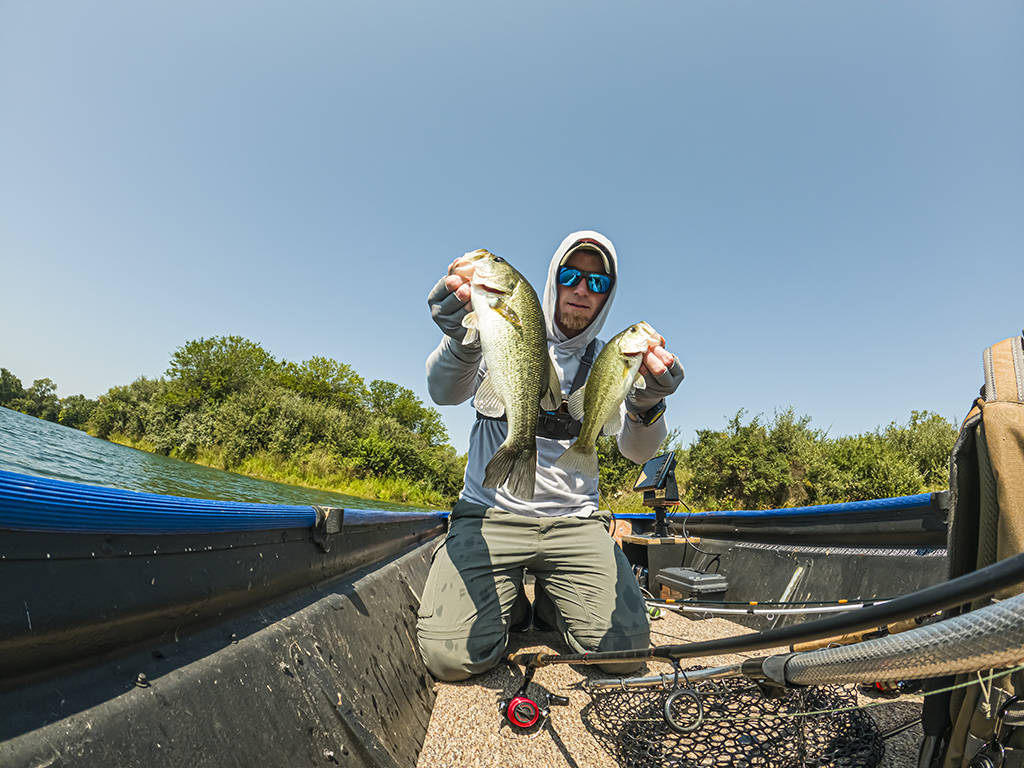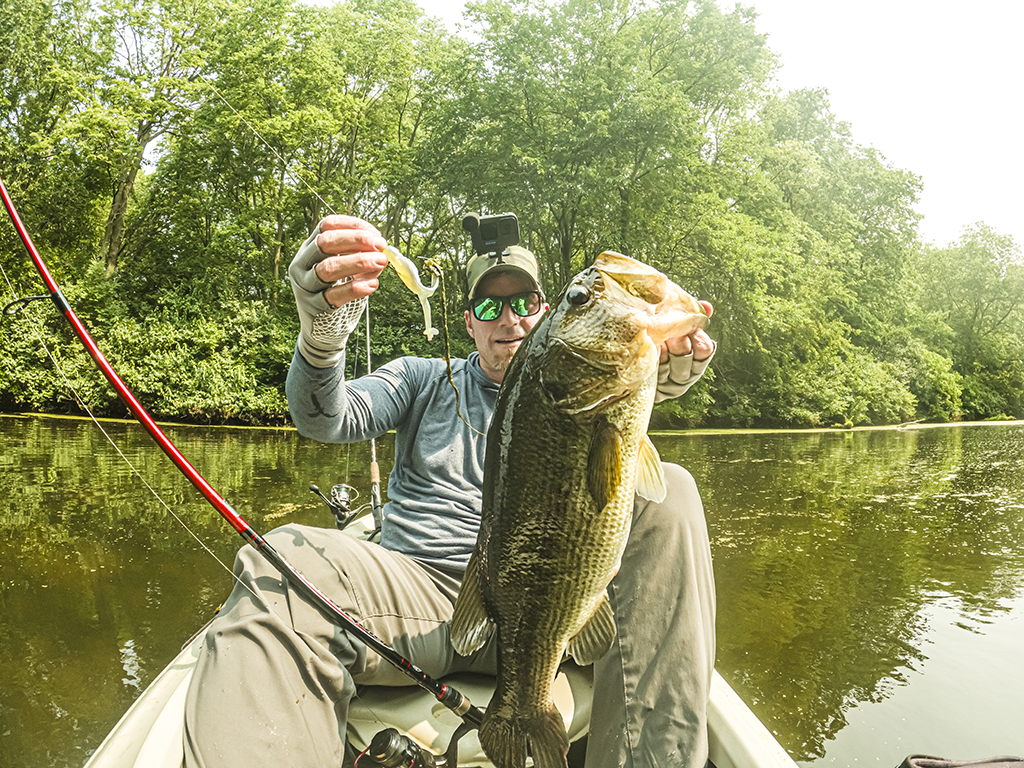I didn’t see it… But I heard it.
My first Midwest frog bite was unreal. There might have been some cinematic blow-up. But if there was, I missed it. After fishing for hours and hours with little activity, daydreaming had taken over. I may have been looking at the birds or the clouds. Thinking about work, family, or that silly meme my buddy texted the night before – one with a Bass staring at a Ned rig, thinking, “Is this what we’ve become?”
Then suddenly, I heard a sound I’ll never forget. A deep, guttural, echoing slurp buried within the slop and duckweed that caused me to freeze mid-retrieve.
“Was that… Was that a fish?! Where’s my frog?!”
I set the hook hard. Felt weight. The actual battle was short because the Bass was living in less than a foot of water next to the shore. Within seconds, I had her in my grasp. Big, beautiful – a deep green monster with an even darker lateral line and bright red gills that created contrast in coloring so intense that it stirred something deep within my soul. What a specimen!
I didn’t think Illinois held Bass like this. But in that instant, I realized: the Bass were definitely here… I’d just been fishing for them all wrong.
Mastering Midwest Bass Fishing
I didn’t always fish in the Midwest. Not seriously. My family didn’t have much money, but somehow, Grandma and Grandpa Ulrich managed to get their hands on a little lake house before Wisconsin property became outrageously expensive. We vacationed there because, well, Grandpa didn’t charge us. Talk about spoiled!
The clean, clear lakes on the chain contained visible weed lines and structure you could read like a book. We’d fish bobbers and jigs while Dad used spoons, crankbaits, and other “adult” presentations – and flat out caught fish. This, to me, was fishing.
When we’d return home, the water in Illinois was much different. The lakes were murky, tannic, or covered in muck. The rivers carried sediment, which made them seem dirty. But in reality, they just had lower visibility.
I couldn’t fish bobbers in the muck, and my jigs weren’t visible enough in low-visibility water to be effective. So I quit fishing.
Not completely. Just until we got back to Wisconsin the following summer. Back to “real fishing.”
Somewhere along the way, we got too busy to go up to Wisconsin. Grandpa ended up selling that house. I’m guessing he (at least) quadrupled his investment. Time passed and I got married, had kids… But in time, the pull to fish again became more and more intense. I’d see those images of fish at the lake and think to myself, “I want my kids to have that, too.” The problem was that I didn’t have access to Wisconsin waters. So I needed to find fish closer to home.
That’s when I decided to master Midwest Bass fishing.
Life was hectic – and still is. Building three companies and supporting a wife and five kids as the sole financial provider doesn’t leave much free time. So when I did get a chance to fish, I needed to make it count. I dusted off the gear, gave Illinois’s waters another shot, and got humbled. Then obsessed.
Mastering Minimalist Fishing
Over the past six years, I’ve refined a minimalist, strategic approach that lets me fish effectively – even with limited time. I’ve discovered that the fish are here. Big ones. You just have to adapt.
In this guide, I’ll walk you through how I approach any new body of water and break down two very different categories of fishing scenarios common across the Midwest. I’ll also explain how I prep for each one using a concept I call the “Base Box”, so you’re never unprepared, no matter what kind of water you’re facing. These tips and techniques will help you catch fish all over the Midwest – and beyond!
Midwest Bass Fishing Tip #1: Pre-Fishing Prep is Key
In my last piece for FishingBooker, I ran through 3 Expert Creek Fishing Techniques. Several of the points mentioned there overlap with what I’m sharing with you today. The process of triggering on top, scouting subsurface, then mopping up on bottom is a solid way to approach any body of water – but before we wet a line, we have to discuss the most un-sexy topic in fishing…
Preparation

Proper preparation ensures you bring only what you need – nothing more. This is a minimalist fishing approach that I’ve been developing since returning to Midwestern waters in 2019.
Less gear keeps you focused. Instead of thinking about all the things you could throw, you tend to focus on the task at hand. How am I working this bait? What targets can I key in on? Are those targets fruitful and holding fish, or are they barren? Repeat.
I only allow myself to take a single Plano container in a backpack that contains some standard terminal tackle and a handful of plastics. This Plano container is what I call a Base Box. A Base Box is exactly what it sounds like: my base – my foundation. It holds my must-haves for a specific type of water. It forces discipline and clarity. What’s more, it results in more fish, not less.
How to Build a Base Box
Think about the three main zones of any body of water that you’ll encounter – top, subsurface, and bottom. These apply to every body of water. Even a pond with a max depth of 4 feet has a top, subsurface, and bottom area. But the primary variable is always the absolute depth you’re potentially targeting.
Are you fishing less than 4 feet of water? Or trying to reach down to 40? That variable affects your bait choices, your weights, and your gear. You don’t need 40 lures, but you do need a few great options for each zone.
Create a Base Box for every type of water you plan to fish: a creek fishing Base Box, a river fishing Base Box, a heavy wood cover Base Box, a muck and slop Base Box, etc. Just make sure each one provides quality presentations for these three zones:
- Topwater. Maybe it’s a frog, a popper, or a buzzbait, depending on vegetation and visibility.
- Subsurface. Something like a swimbait, a crankbait, or a suspending jerkbait.
- Bottom. A jig, a worm, or a compact creature bait with enough weight to get down.
The beauty of the Base Box is its simplicity. One backpack, one rod, one box – and you’re dialed in. You’ll move lighter, fish longer, and waste less time second-guessing your rig.
Minimalist fishing is the careful accumulation of quality behaviors, knowledge, skill, technique, and gear. It is not fishing with a stick and a hook like a caveman. Minimalist fishermen catch more fish by constantly evaluating and optimizing what they do on and off the water. They believe wholesome experiences are more valuable than things, and keep only the tools that produce results while intentionally discarding the clutter.
Developing your own collection of laser-focused Base Boxes dovetails perfectly with discarding clutter. Let me give you two important examples for all Midwest fishermen…
Midwest Bass Fishing Tip #2: How to Fish Muck-Covered Lakes, Ponds, & Canals
Muck, mats, slime, algae, scum… Like it or not, this is Midwest fishing, brothers! Our water is often covered.
But here’s the truth: some of the biggest Largemouth Bass live in the nastiest stuff. Why? Because we avoid it. Most people don’t want to mess with it. But Bass do. They tuck in tight to the cover, waiting for anything edible to make a mistake. They enjoy the shade, the slightly cooler water, abundant food, and security provided by this thick, sticky, nasty slop.
To them – the thicker and nastier, the better.
Mucky Water Gear

Rod & Reel. Go with a long, fast-action, high-powered rod. A 7-foot or a bit longer usually works well. I’ll usually opt for a baitcaster with serious cranking power and drag (over a super-fast rocket-style reel). But heavy spinning rods and reels also have their place in my arsenal. For example, if I’m kayak fishing topwaters around heavy muck, my heavy spinning combo gets the nod. If I’m on the bank or in the jon boat, a baitcaster is the weapon of choice.
Line. 30 to 60 lb braid minimum. Nothing less.
Hooks. Heavy-gauge, EWG, or straight-shank hooks that won’t bend out under pressure.
Once you have the rig, be mentally and physically prepared to pull hard. You’re not just hooking fish – you’re violently dislodging them from nature’s Velcro.
My Base Box for this situation?
A weedless frog or crowbar rig (top), swim jig or a heavy sinking stickbait (subsurface), and a soft plastic creature bait with a pegged weight Texas rig or a heavy weedless jig (bottom).
Is it frustrating? Usually. But the rewards are massive. Literally. These Bass don’t see a lot of pressure, and when they hit, it’s violent hand-to-hand combat!
Midwest Bass Fishing Tip #3: How to Fish Deep, Clear Pits

Another favorite for many a Midwest Bass fisherman is the polar opposite of the mucky mess mentioned above. It’s also one of my favorite types of water to fish, because it demands long casts, finesse, and precision at a very high level to be successful. Poor planning and sloppy technique will result in the dreaded skunk. I’m talking about deep, clear Midwest pits.
Pits are different from creeks, rivers, lakes, and ponds. They’re often former quarries (borrow pits) or man-made lakes with steep drop-offs, rocky shelves, and open water. You’ll rarely see visible cover like weeds and algae, but that doesn’t mean there aren’t fish.
The water is clear. Visibility is insane. To fish here, you have to go light:
Start with a long spinning rod and the lightest line you can get away with. 4-pound Seaguar Invisx fluorocarbon is common for me. Plan on long casts and staying as far back from the area you’re fishing as possible. When you hook a fish, take your time and play them back to the boat. In deep, clear water like this, you don’t have to worry about them getting wrapped up or gaining leverage to tear free. Enjoy the fight!
Clear Pit Fishing Base Box
When I fish here, my gear and my Base Box shift completely. A smaller walking bait or prop bait (top), a 3″ swimbait on a light jig head or a suspending jerkbait (subsurface), and a light jig worm, Ned rig, or even a drop-shot (bottom) do the trick.
Watch for bait fish activity, bird movement, and transitions in bank structure. Once you find depth, structure, and bait, set up shop and pick it apart.
Is Midwest Bass fishing worth it?

I still miss my Grandpa’s little Wisconsin house. We made many great memories there, and my father planted the seeds that would later sprout into my love of fishing right there on that chain o’ lakes. We all loved it – so much, in fact, that a few years ago my family decided to pool some money together. While we can’t afford to buy a place, we can afford to rent one.
We’re leaving tomorrow – and I can’t wait. I’ll be sure to report back and let you know how it goes, and share the Wisconsin Base Box that I’m taking with me.
But soon, I’ll return to the Midwest to fish the muck-covered lakes and deep borrow pits that demand precise, location-specific gear and techniques… And I can’t wait for that, either. Midwest Bass fishing isn’t easy. But it’s definitely worth it.
After six years of focused effort, I’ve learned that these lakes, pits, and creeks hold incredible fish – and better yet, incredible experiences. It just takes the right mindset and a willingness to adapt.
Your next lunker is out there. Take these techniques, apply them, and get to work. There’s nothing better than hoisting a healthy green behemoth toward the sky after executing a strategy you built yourself.
It’s a gift. It’s a reward. And that’s why we fish. Tight lines and Godspeed, patriots.
